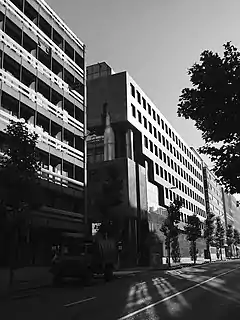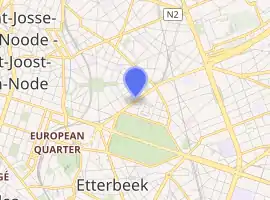Kortenberg building
The Kortenberg building is the office building of the European Union (EU) in Brussels, Belgium that houses most bodies related to the Common Security and Defence Policy (CSDP).
| Kortenberg building | |
|---|---|
French: Cortenbergh | |
 | |

| |
| General information | |
| Type | Office building |
| Architectural style | Postmodern |
| Location | Brussels, Belgium |
| Address | French: Avenue de Cortenbergh 150 Dutch: Kortenberglaan 150 1000 Brussels, Belgium |
| Coordinates | 50°50′43″N 4°23′24.5″E |
| Current tenants | Common Security and Defence Policy (CSDP) bodies of the Council of the European Union and European External Action Service |
Architecture
The postmodernist, L-shaped building was designed the architectural firm ARCHI + I, and is located at the corner of rue Le Titien. Towards avenue de Cortenbergh, eight floors, the last of which is set back; towards rue Le Titien, four floors surmounted by the glass roof of the auditorium. Windows with aluminum frames forming a glass base on the first two levels; then going up level by level in a staircase to reach the top of the building on the rue Le Titien side; the glass roof then describes a slope up to the height of the neighboring houses. The rest of the facades in red Indian granite: granite of the base and the blind bay towards rue Le Titien unpolished; disc patterns under the unpolished windows also. Entrance of modest size between two colossal stainless steel columns rising to the full height of the building and appearing to cross the granite blocks. Rear facade alternating bands of red and brown bricks.
The interior consists of modest offices around central corridors, and an indoor garden.
History
The building was constructed in 1977 for an insurance company.[1]
This use of the building started after the establishment of the European Security and Defence Policy (ESDP), the CSDP's precursor, in the early 2000, under the auspices of High Representative Javier Solana, who stated on several accasions the need to build a 'strong in-house strategic culture'.[2]
Most of the newly established European External Action Service (EEAS) has been situated in the Triangle building at the Schuman roundabout since 2012, however for security reasons CSDP departments were unable to move to this building 500m away.[3]
CSDP tenants
Part of the European External Action Service (EEAS):
- European Union Military Staff (EUMS), including its Military Planning and Conduct Capability (MPCC)
- Civilian Planning and Conduct Capability (CPCC)
- Joint Support Coordination Cell (JSCC)
- Crisis Management and Planning Directorate (CMPD)
CSDP agencies outside the EEAS:
- European Defence Agency (EDA)[4]
- European Union Satellite Centre (SatCen)
The MPCC, JSCC and CPCC together form the permanent military/civilian strategic level facilities in the EU command and control structure.
The EU command and control (C2) structure, as directed by political bodies which are composed of member states's representatives and generally require unanimous decisions, as of April 2019:[5]
- Liaison: Advice and recommendations Support and monitoring Preparatory work
| Political strategic level: | |||||||||||||||||||||||||||||||||
| ISS | EUCO Pres. (EUCO) | Chain of command | |||||||||||||||||||||||||||||||
| Coordination/support | |||||||||||||||||||||||||||||||||
| SatCen | CIVCOM | HR/VP (FAC) | |||||||||||||||||||||||||||||||
| INTCEN | HR/VP (PMG) | HR/VP (PSC) (******) | CEUMC (EUMC) | ||||||||||||||||||||||||||||||
| CMPD | DGEUMS (***) (EUMS) | ||||||||||||||||||||||||||||||||
| Military/civilian strategic level: | |||||||||||||||||||||||||||||||||
Dir MPCC (***) (MPCC) | JSCC | Civ OpCdr CPCC(*) | |||||||||||||||||||||||||||||||
| Operational level: | |||||||||||||||||||||||||||||||||
| MFCdr (****) (MFHQ) | HoM (*) | ||||||||||||||||||||||||||||||||
| Tactical level: | |||||||||||||||||||||||||||||||||
| CC(**) Land | CC(**) Air | CC(**) Mar | Other CCs(**) | ||||||||||||||||||||||||||||||
| Forces | Forces | Forces | Forces | ||||||||||||||||||||||||||||||
- *In the event of a CSDP Civilian Mission also being in the field, the relation with the Civilian Planning and Conduct Capability (CPCC) and its Civilian Operation Commander (Civ OpCdr), as well as the subordinate Head of Mission (HoM), are coordinated as shown.
- **Other Component Commanders (CCs) and service branches which may be established
- ***The MPCC is part of the EUMS and Dir MPCC is double-hatted as DGEUMS. Unless the MPCC is used as Operation Headquarters (OHQ), either a national OHQ offered by member states or the NATO Command Structure (NCS) would serve this purpose. In the latter instance, Deputy Supreme Allied Commander Europe (DSACEUR), rather than Dir MPCC, would serve as Operation Commander (OpCdr).
- ****Unless the MPCC is used as Operation Headquarters (OHQ), the MFCdr would be known as a Force Commander (FCdr), and direct a Force Headquarters (FHQ) rather than a MFHQ. Whereas the MFHQ would act both on the operational and tactical level, the FHQ would act purely on the operational level.
- *****The political strategic level is not part of the C2 structure per se, but represents the political bodies, with associated support facilities, that determine the missions' general direction. The Council determines the role of the High Representative (HR/VP), who serves as Vice-President of the European Commission, attends European Council meetings, chairs the Foreign Affairs Council (FAC) and may chair the Political and Security Committee (PSC) in times of crisis. The HR/VP proposes and implements CSDP decisions.
- ******Same composition as Committee of Permanent Representatives (COREPER) II, which also prepares for the CSDP-related work of the FAC.
See also
- Triangle building, the nearby main seat of the European External Action Service
- Brussels and the European Union
References
- http://www.irismonument.be/fr.Bruxelles_Extension_Est.Avenue_de_Cortenberg.150.html
- Norheim-Martinsen, Per M. (November 2, 2013). The European Union and Military Force: Governance and Strategy. Cambridge University Press. ISBN 9781107028906 – via Google Books.
- https://www.defense.gouv.fr/content/download/327813/4516088/file/Laboratoire%20n%C2%B023%20(En).pdf
- "The birth of an Agency". www.eda.europa.eu.
- EU Command and Control, p. 13, Military Staff
